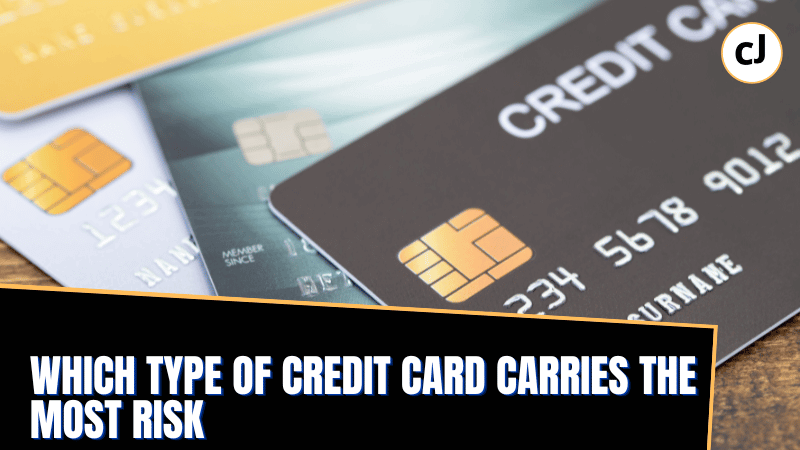We all use credit cards, some on a daily basis, and while they are a great tool if used smartly, credit cards can also come with risks both to the people who use them, and for the bank or financial institution that issued the card.
Let’s look at a few type of credit cards and learn about their risks or advantages.
Key Takeaways:
- Credit cards with high interest rates and variable interest rates are more risky for the person using them. Variable interest means you won’t know exactly how much you are charged until you do, and also the high interest can cumulate and if you carry large debt you basically pay interest on interest.
- Cards that have high upfront fees or yearly fees are also risker – together with a complex rewards system, these means that you will never really earn anything from using the card as you will most likely just pay the fees and don’t get enough points to purchase something.
- For the banks, a risky card means a person with bad credit, or someone with no stable income ( although banks are usually pretty good at knowing who to approve for a card and who they should pass on )
NOTE – Remember, from the banks point of view, if you carry debt it is a GOOD thing for them, because that’s how they earn the most with interest etc. So they usually want customers that will use debt, but will be able to pay it off over time with no issues.
Quick Navigation
Types of Credit Cards With Higher Risk
Here are several of the more risker credit card types that you may want to approach with more caution and care.
| Credit cards with extremely high APRs attached | Credit cards that have a restricted low credit limit |
| Credit cards with high fees – upfront | Credit cards that have a no credit reporting policy |
| Credit cards with high fees – ongoing | Credit cards that boast of rewards programs that are complicated and confusing |
| Credit cards that promote deferred interest |
Credit cards with extremely high APRs
APR means Annual Percentage Rate, which is basically how much interest are you going to pay on your credit card balance. While all cards have this, as nothing is for free obviously, the more riskier cards will have a high APR that can sometimes climb to the high 40%. At this rate you are basically paying interest on your purchases and not the purchase itself.
Make sure to compare these rates with a few reputable companies before signing on and make sure your rate is on average the same as the industry.
Credit cards with high fees – upfront
Some card companies like to charge upfront fees, they might offer average APR which makes you think it’s a good deal, but if you add up the upfront fees ( or worse, yearly fees ) you can come up to a poor card that will be expensive to hold.
Make sure you know if there are any fees upfront or any, and make sure they are inline with the industry and not high for no reason.
NOTE – The only exception to this would be a card that offers you something special in return to charging an upfront fee, for example if you love going to shows and movies and that specific card offers great discounts on tickets, it might make sense to use it as it offsets with the full price of tickets.
Credit cards with high fees – ongoing
Similar to the point above about upfront fees. Some card will come with ongoing fees that you pay yearly or even monthly.
Watch out for those as they can quickly add up and in most cases the fees do NOT offset with offers the card suggests. This is especially true for people who do not use their credit card that often so they will basically just be paying fees for nothing.
Credit cards that promote deferred interest
These type of cards can go either way – If you are responsible with your money, and pay off your debt on time, these type of cards can actually be a good thing, as they usually offer 0% interest for a limited time. So if you know you can pay it back at a later stage, you can use that credit and basically get free money ( free for a while )
On the other hand, if you are NOT responsible with money ( and most people are not ) you will fall into the trap of these cards, you spend a lot of money because it carries no interest, and by the time the payment is due, you will suddenly notice you don’t have enough to pay it off, and interest starts piling on. Very dangerous.
Credit cards that have a restricted low credit limit
While in theory these cards don’t sound too risky, they could have a negative effect on your credit score, and your spending ability.
When you have a low limit on your card, even small purchases can add up and eat away at your credit utilization ratio.
When your utilization ratio is high, it will hurt your credit long term, you usually want to keep your utilization to below 30% of your limit at all times.
So while these cards are less risky compared to the ones mentioned above, they do still carry some risk to you as a consumer.
Credit cards that have a no credit reporting policy
These type of cards carry lower risk, as they do not hurt you directly, but if they don’t report your activity, you won’t build up your credit history and credit score. So you might as well use a debit card right?
So in effect these type of card hurt your ability to build credit.
Though not risky as such, they are indeed problematic because they won’t be doing you any good.
Credit cards that boast of rewards programs that are complicated and confusing
Credit card statements are usually very confusing, let’s just face it. However while the balance itself might be confusing, the reward system should not.
When you sign up, you should know how many points you get for each purchase, and how to use them.
For example some cards offer 1.5% points on every purchase. That’s it, very easy to understand right?
If you try to understand where are your points, and how do you use them, and you can’t quickly figure it out, maybe look for a different card to use.
Why are credit cards risky in nature
What We Mean When We Talk About Risk with Credit Cards
All credit cards carry some form of risk with them. How you manage against that risk is the deciding factor on how your financial future will play out.
Having said that, as you read in the post here, some cards carry more risk to you than others, and some are straight up just not worth it.
All credit card providers have an obligation to highlight their interest rates, terms, and conditions. Make sure you take the time to read through it and understand the risks of each card.
These includes their:
- APR rates
- Fees
- Rewards system
- Deferred interest propositions and more.
These are the credit cards that the experts suggest are high-risk choices. And it is these that you should make yourself aware of before making your application.
How to Ensure You Choose a Safer Credit Card Option
1. Perform a credit cards comparison
With so many search engines online now, it has never been easier to perform a legitimate credit card comparison search.
Do some homework before you make that final card decision. Write a list of what you’re looking for in a credit card and aim your search around this.
Look at the customer ratings and value for money section of the comparison charts. Note all the benefits and, indeed, potential drawbacks of all providers.
2. Find out what your credit cards APR is straightaway.
Once you know the APR, make sure it remains this way throughout your contract term.
Look at the current APR average and consider what is about right at that time. If you see those advertised much higher, avoid these, for this is a red flag.
Furthermore, ensure that what you are quoted at the beginning of your search for APR is what you will definitely get when applying.
Some credit card providers will quote the APR as a range. So, you may not always receive what you initially saw advertised.
Thought this can very well be due to personal factors and circumstances, it does pay to know about this change before proceeding.
3. Read all the terms and conditions looking for any hidden rates before signing your credit agreement
Those risker credit card providers are quite good at the rhetoric they use in their sales pitches.
So, it’s often not until you’re signed up having skipped the T’s & C’s that you find yourself being charged for more items. These are the items you perhaps had no idea existed until now.
Make sure there are no hidden costs or fees tucked away in that black and white sheet.
This can be anything from penalty APRs to missing payment charges and foreign transaction fees as a start.
4. Understand that those cards with an introductory zero APR rate will eventually start charging you this at some point!
A common error many people are guilty of is forgetting that once the APR free year is over, the next year will start to accumulate such interest.
For some, this can come as a bit of a shock. That is, especially if they weren’t expecting any extra charges that month!
So, it is those years you need to ensure you know exactly what APR you will be paying. You don’t want to be hit later on down the line with increasing rates, so make sure it’s confirmed before taking on the card.
5. Consider whether those special offers really are worth it
If your credit card attracts an annual fee, as some will, investigate if it’s worth it.
This means looking closely at the rewards that you are likely to earn from having this card. Then see if they outweigh that of the required fee.
If they don’t, it’s not worth the extra costs and means you’ll be paying more for having a card that offers you little incentive or rewards back as a result.
Final Thoughts
In conclusion, the reality is that with every card you use, you take on some sort of risk, but educating yourself about the things we talked about above will help you mitigate that risk and even thrive.


1 thought on “Which Type of Credit Card Carries the Most Risk and Why?”